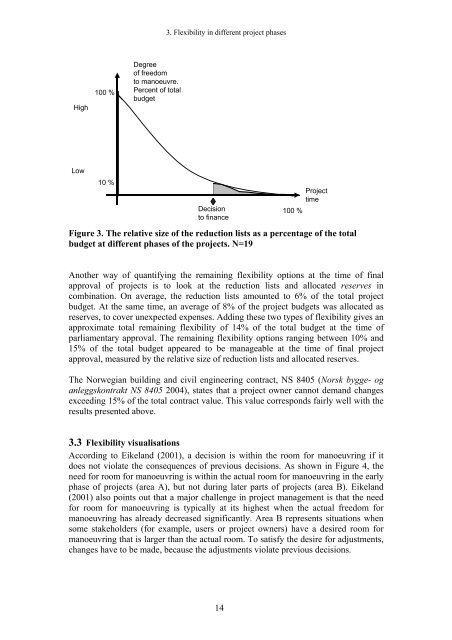Link to thesis - Concept - NTNU
Link to thesis - Concept - NTNU
Link to thesis - Concept - NTNU
You also want an ePaper? Increase the reach of your titles
YUMPU automatically turns print PDFs into web optimized ePapers that Google loves.
3. Flexibility in different project phasesHighLow100 %10 %Degreeof freedom<strong>to</strong> manoeuvre.Percent of <strong>to</strong>talbudget100,0 %90,0 %80,0 %70,0 %60,0 %50,0 %40,0 %30,0 %20,0 %10,0 %Project0,0 %time0 10 20 30 40 50 60 70 80 90 100Decision100 %<strong>to</strong> financeFigure 3. The relative size of the reduction lists as a percentage of the <strong>to</strong>talbudget at different phases of the projects. N=19Another way of quantifying the remaining flexibility options at the time of finalapproval of projects is <strong>to</strong> look at the reduction lists and allocated reserves incombination. On average, the reduction lists amounted <strong>to</strong> 6% of the <strong>to</strong>tal projectbudget. At the same time, an average of 8% of the project budgets was allocated asreserves, <strong>to</strong> cover unexpected expenses. Adding these two types of flexibility gives anapproximate <strong>to</strong>tal remaining flexibility of 14% of the <strong>to</strong>tal budget at the time ofparliamentary approval. The remaining flexibility options ranging between 10% and15% of the <strong>to</strong>tal budget appeared <strong>to</strong> be manageable at the time of final projectapproval, measured by the relative size of reduction lists and allocated reserves.The Norwegian building and civil engineering contract, NS 8405 (Norsk bygge- oganleggskontrakt NS 8405 2004), states that a project owner cannot demand changesexceeding 15% of the <strong>to</strong>tal contract value. This value corresponds fairly well with theresults presented above.3.3 Flexibility visualisationsAccording <strong>to</strong> Eikeland (2001), a decision is within the room for manoeuvring if itdoes not violate the consequences of previous decisions. As shown in Figure 4, theneed for room for manoeuvring is within the actual room for manoeuvring in the earlyphase of projects (area A), but not during later parts of projects (area B). Eikeland(2001) also points out that a major challenge in project management is that the needfor room for manoeuvring is typically at its highest when the actual freedom formanoeuvring has already decreased significantly. Area B represents situations whensome stakeholders (for example, users or project owners) have a desired room formanoeuvring that is larger than the actual room. To satisfy the desire for adjustments,changes have <strong>to</strong> be made, because the adjustments violate previous decisions.14
















